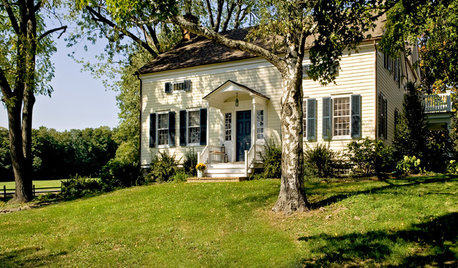Finding the right spray treatment
l_d_g
9 years ago
last modified: 9 years ago
Featured Answer
Sort by:Oldest
Comments (39)
Wes
9 years agoUser
9 years agoRelated Discussions
Where to find best bargains in window treatments?
Comments (18)Choosing WTs has got to be one of the most challenging aspects of home decor--not to mention stressful if you are in a bind and need privacy. I would not rush into it or feel you need to do it all at once, since WTs can really help set the mood of a room. I even used some disposable paper blinds for a few months when we first moved back home after our remodel and I needed something for the front window of our LR that faced the street as I had not yet decided how I wanted to decorate the room. I've found JC Penney (when on-sale which they usually are) to provide a nice balance of quality, price and customer support. If you have all your measurements handy, the staff is very helpful in the custom drapery department, even if you don't order custom drapes. I just ordered a rod/rings there yesterday which were 40% off plis I had another 15% off coupon which can be easily downloaded onto of that. I am planning to do the dropcloth curtains that Red mentions above in my DS's room. I really like the look and you cannot beat the price at $10 per panel. I've attached a link below that not only uses dropcloth curtains, but spray painted PVC pipe as a frugal alternative to an expensive curtain rob. A better idea might be to use a closetpole and paint it for a wood look. If you do a little research there are many frugal options to get a custom look for a fraction of the price. But, before ordering, I would spent a lot of time deciding what you want and what you need. If you post pictures here, you will find many helpful suggestions how to dress your windows, esp. your sliders which can be a challenge. For large windows, if you need operable drapes the options are not inexpensive because of the amount of material you will require as well as the cost of the rod/rings. For a picture window, a nice look if you do not need total privacy, is to use woven wood blinds layered with stationary panels to either side to give a look of softness and texture. Though it may seem more costly as you are ordering two treatments instead of one, in fact, it can be less costly if you are able to use standard sizes and not require something to be custom made. This can even be done for sliding doors if you do an outside mount that clears the door. For ease of operation and full privacy control, either a pinched pleat or grommit top drape are good options. Grommit tops have the advantage that they stack back tighter if space to the sides of the sliding door is limited and you do not want to obstruct the door. Here is a link that might be useful: Drop cloth curtains...See MoreHow to find someone to help me with window treatments?????
Comments (1)Hi Sandyinva -- You've come to the right place for advice and feedback, but the first thing to do is post photos of the room and you'll get lots more feedback. If you are interested in textured material, check out the Pottery barn Peyton drapes, they are a cotton/linen blend and very textured and pretty. Good luck! On sal and free shipping. Good luck!...See MoreLooking but no finding... wall treatment transitions?
Comments (8)This doesn't seem to difficult. When we put up tongue and groove paneling in our former diningroom, we transitioned to drywall in the kitchen. Does this company make prefinished trim pieces to match? If not, maybe you could match the stain yourself. I would think if you ran the pine right up to the cabinets, you could use a 1/2" (or what ever size needed) quarter-round piece just between the uppers and lowers to transition down to the stainless. For the countertop, I would notch out the countertop overhang material around the pine, or even notch out the pine to allow for the overhang (but this may not look as good due to the pine expanding and contracting). As for transitioning the stainless to tile, I would treat it like a transition between drywall and tile. Either just a staight caulked or grouted edge, bull-nose edge pieces, or pencil trim type pieces. I think your idea can absolutely work, just think on it a little more!...See MoreWhat is the right window treatment for this window? Help!
Comments (24)@Melndo The walls are Benjamin Moore Rockport Gray: https://www.benjaminmoore.com/en-us/color-overview/find-your-color/color/HC-105/rockport-gray?color=HC-105 Our window is north facing as well. There is a large Japanese maple near the window so we don't get a ton of light there. I have the floor lamps, two table lamps and a light on the ceiling that isn't in the picture to make sure the room gets enough light. We actually use this room as a music room. There is a piano on the wall that isn't in the picture. Hope this helps! Glad you like it. :)...See MoreUser
9 years agol_d_g
9 years agoUser
9 years agoWes
9 years agol_d_g
9 years agoUser
9 years agol_d_g
9 years agoUser
9 years agol_d_g
9 years agoUser
9 years agol_d_g
9 years agoUser
9 years agoUser
9 years agol_d_g
9 years agoUser
9 years agol_d_g
9 years agoUser
9 years agol_d_g
9 years agoUser
9 years agol_d_g
9 years agolast modified: 9 years agol_d_g
9 years agoUser
9 years agol_d_g
9 years agoUser
9 years agol_d_g
9 years agoUser
9 years agol_d_g
9 years agoUser
9 years agol_d_g
8 years agoUser
8 years agol_d_g
8 years agoUser
8 years agol_d_g
8 years agoUser
8 years agol_d_g
8 years agoUser
8 years ago
Related Stories

WALL TREATMENTSTempted to Try Wallpaper? 10 Tips for Finding the Right Pattern
Before you lay down a lot of cash, sit down with this advice for getting a wallpaper you’ll love for years
Full Story
WALL TREATMENTSCan't Find the Right Wallpaper? Make Your Own
For one-of-a-kind walls, just use your imagination. Custom wallpaper is easier and less expensive than you might expect
Full Story
MOST POPULARFind the Right Glass Door for Your Patio
It’s more than just a patio door — it’s an architectural design element. Here’s help for finding the right one for your home and lifestyle
Full Story
CURB APPEALClues to Finding the Right Color for Your House
Waffling over the rainbow of color options for your home's face? This advice from an architect can help
Full Story
DECORATING GUIDESHow to Get Your Window Treatment Right
Here's the lingo to know to get the draperies you really want
Full Story
MATERIALSInsulation Basics: What to Know About Spray Foam
Learn what exactly spray foam is, the pros and cons of using it and why you shouldn’t mess around with installation
Full Story
PAINTINGBulletproof Decorating: How to Pick the Right Kind of Paint
Choose a paint with some heft and a little sheen for walls and ceilings with long-lasting good looks. Here are some getting-started tips
Full Story
WINDOW TREATMENTSHow to Choose the Right Window Blinds
Get the privacy, light filtering and look you want with this breakdown of blind options
Full Story
WALL TREATMENTSPick the Right Paint Finish to Fit Your Style
The question of finish may be as crucial as color. See which of these 9 varieties suits your space — and budget
Full Story
REMODELING GUIDESCrown Molding: Is It Right for Your Home?
See how to find the right trim for the height of your ceilings and style of your room
Full Story





l_d_gOriginal Author